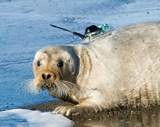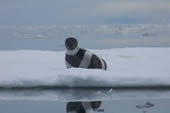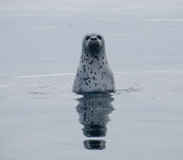
|

|
| Home | Daily Log | the Research | Images and Video | Maps | Data | Q&A | Links |
| Introduction | Physical Oceanography | Nutrient Chemistry | Phytoplankton | Zooplankton | Acoustics/Fish | Seabirds | Marine Mammals |


Bering Sea Ice Expedition Research Activities - Seals (Marine Mammals) |
||||||
|
Four species of ice-associated seals inhabit the Bering Sea: ribbon (Histriophoca fasciata), ringed (Pusa hispida), bearded (Erignathus barbatus), and spotted seals (Phoca largha). These seals are key components of arctic marine ecosystems and they are important resources for the Alaska Natives of northern and western Alaska. The seals that live near shore have been studied for many years but we know very little about the seals that occupy the marginal and inner pack ice zone of the Bering Sea.
In order to answer some of these questions, we are going to have the seals collect data for us. Researchers from NOAA’s National Marine Mammal Laboratory will use small boats to reach ice floes occupied by seals. The seals will be captured using nets, and an instrument will be attached either to the seals’ back using quick-setting glue, or to their flipper like an earring. The instruments attached with glue will fall off with the animal’s next molt (when they lose their hair) which could be between 1 and 11 months. These instruments are called satellite-linked data recorders (SDRs), and they collect information that will be transmitted back to us by satellite and will provide information on:
In a related project we will also conduct helicopter- and ship-based surveys of the pack ice to count seals and identify where they are distributed. We will compare data collected by the different projects of this expedition
(fish, zooplankton, and physical oceanography) with the data collected by
the SDRs and the aerial surveys to better understand the habitat
selection of ice seals in the pack ice ecosystem. This will improve
our understanding of these seals and help us to predict how changing sea-ice
conditions may affect them. |
||||||
| Privacy | Disclaimer | Accessibility | Contact Us |


